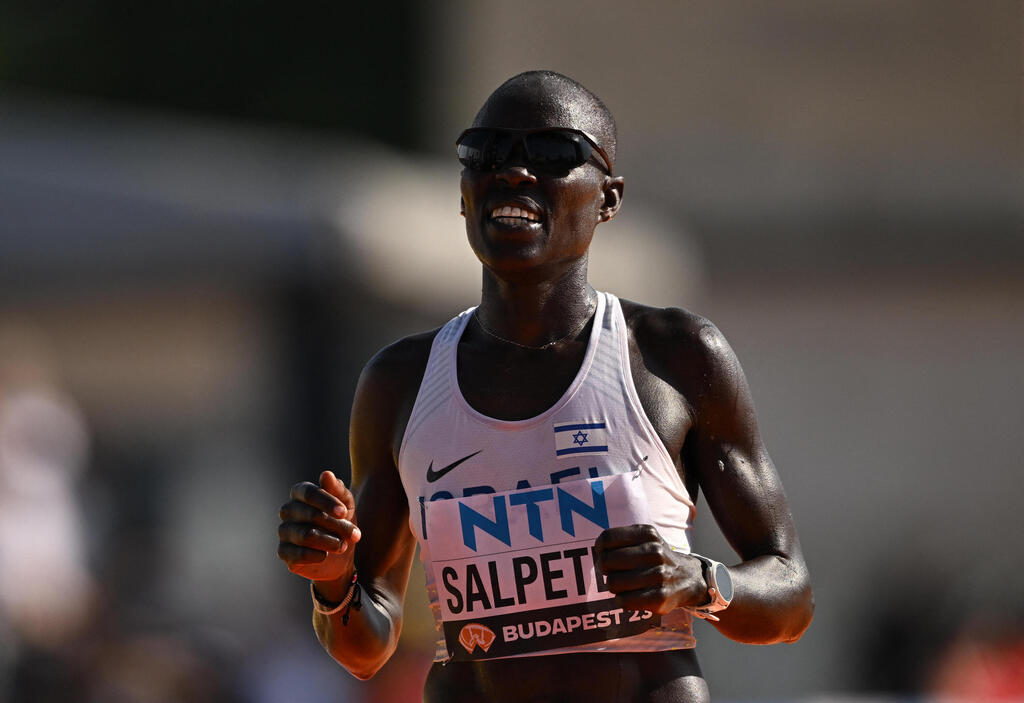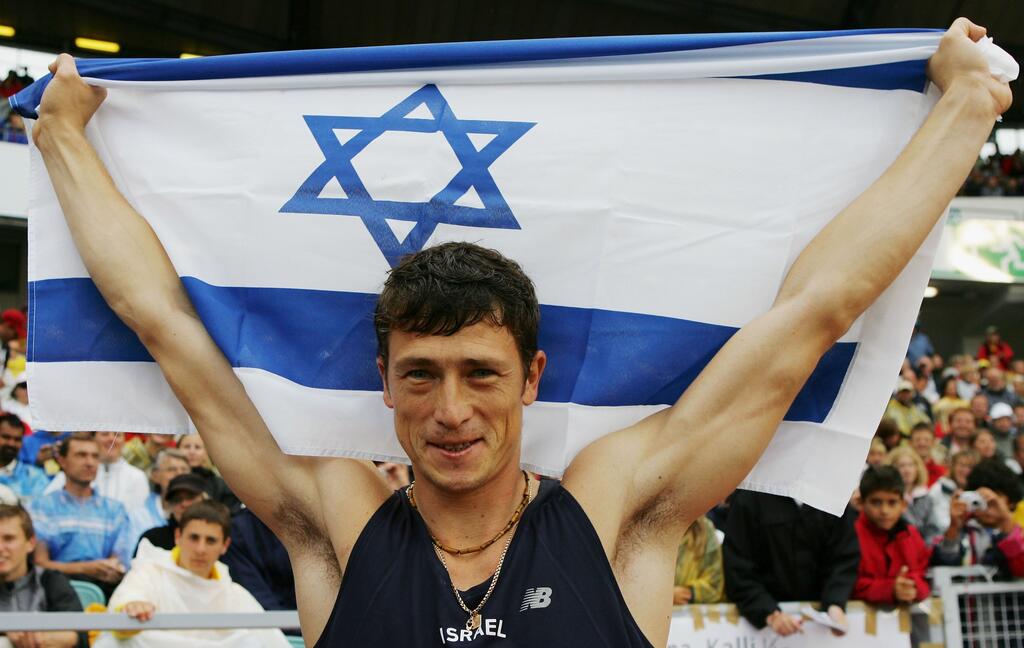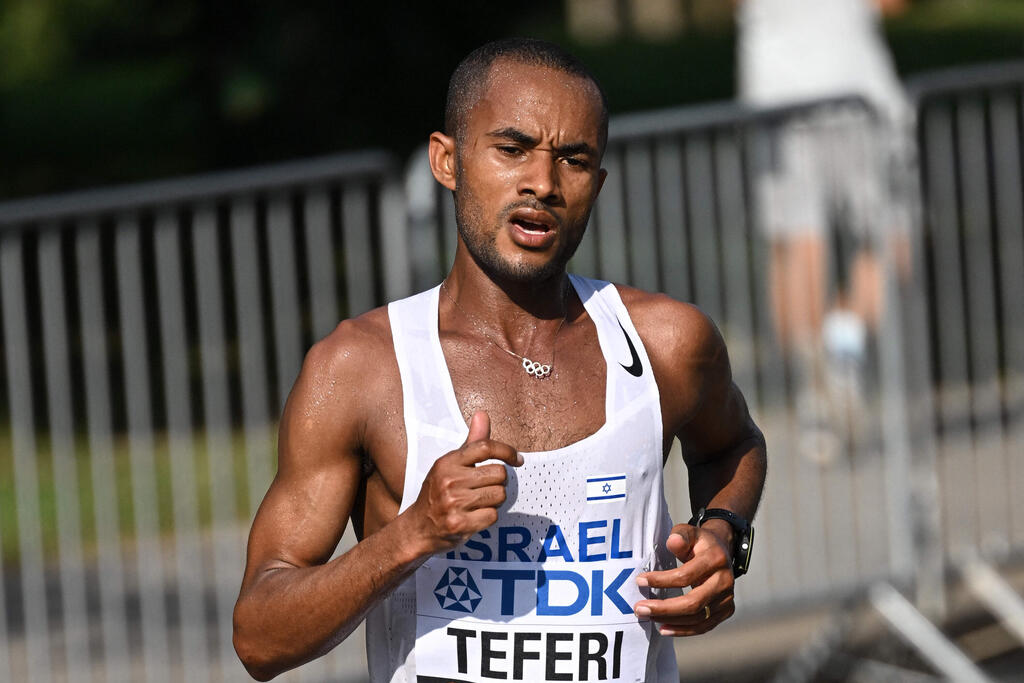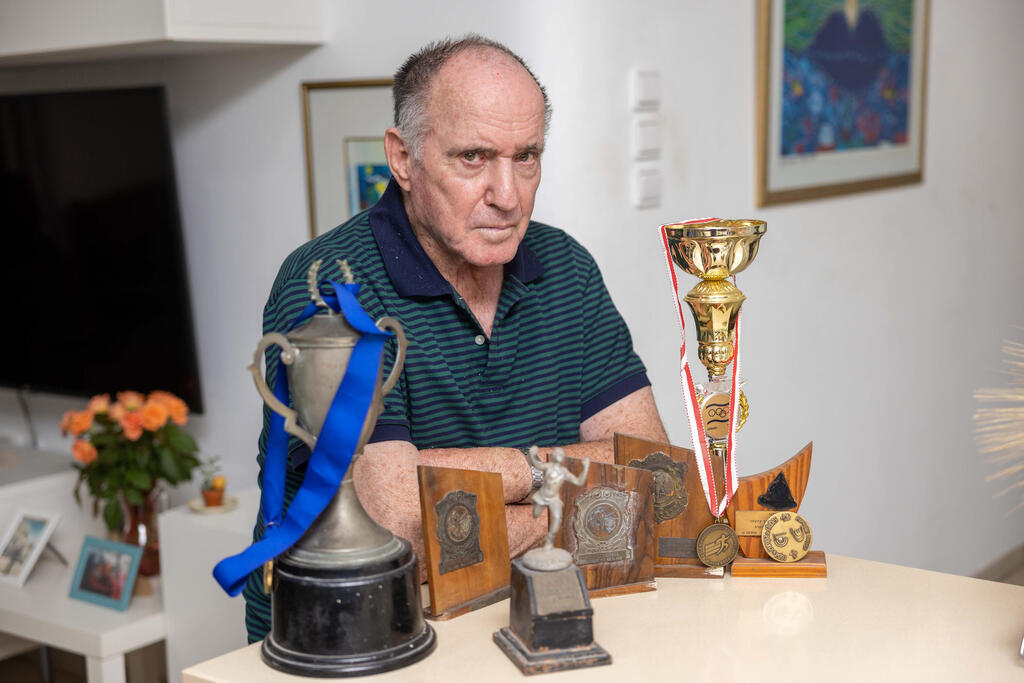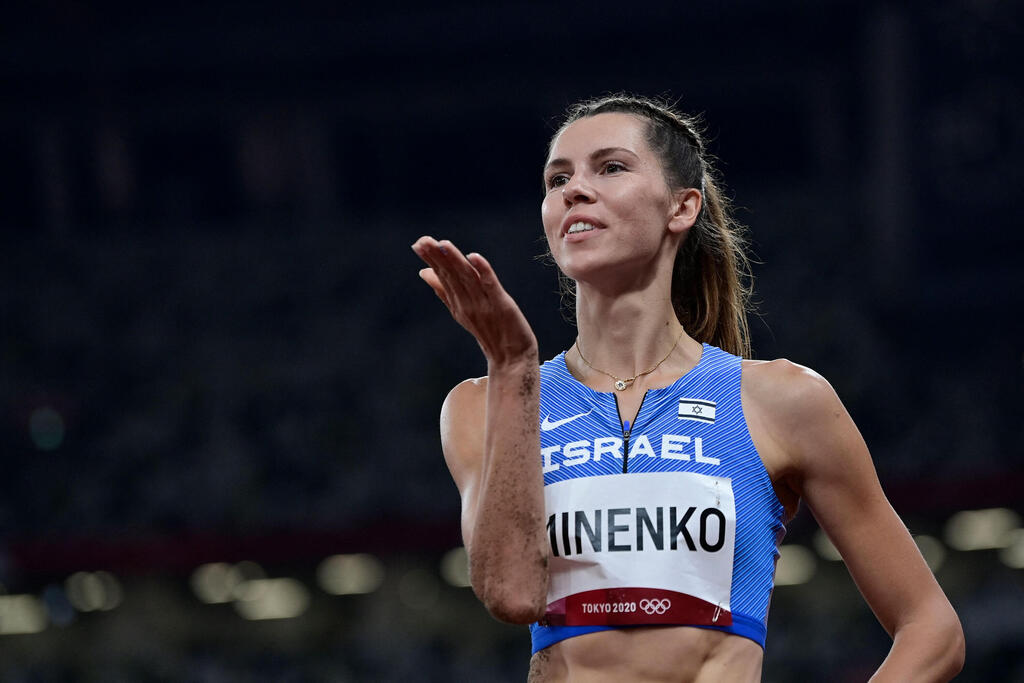Getting your Trinity Audio player ready...
Attorney Arie Koks, former chairman of the Athletics Association, recalls the unforgettable 1991 World Championships in Tokyo with the Israeli delegation. "I traveled with five athletes," he begins. "Expectations were low back then. I thought if anyone ranked in the middle, it would count as a success."
"On the second day, I went to the javelin qualifiers in the morning. From the crowd’s reaction, I realized someone had thrown over 74 meters, but I didn't know who. I looked up at the scoreboard and saw that Vadim Bavikin, an oleh chadash (new immigrant) from Russia, had achieved the distance. Vadim, who excelled in youth athletics in the Soviet Union and had moved to Israel that year with his family unrelated to sports, was a sensation. He finished eighth in the final with 81.56 meters, marking a new era."
The periods before and after 1991 in Israeli athletics are vastly different. Until the 1990s, the quality of achievement was measured by overall placement—being in the upper half was a success, and the lower half was a failure. After 1991, the conversation began to include medals. Israeli athletes have yet to win medals at the Olympic Games, but it’s approaching—perhaps in Paris.
Nine finals, eight olim
The current records indicate that immigrants hold no fewer than 25 national records, more than those achieved by native-born Israelis. The record list includes "reinforcement players" who came to Israel for love, such as Lonah Chemtai Salpeter, Selamawit Bayoulgn-Teferi, Hanna Knyazyeva-Minenko and Donald Sanford. It’s also important to acknowledge the precise nurturing of children of immigrants, like Blessing Afrifah, Noam Mamo and Diana Vaisman, who came to Israel at age two.
A remarkable statistic: Of the nine Olympic finals in athletics reached by Israelis, eight occurred from 1992 onward, all thanks to new immigrants who propelled Israeli sports forward. Without them, Esther Roth-Shachamorov, who reached the 100m hurdles final in 1976, might have remained alone.
Sports culture and education were always prominent in the Soviet Union, especially in large cities where every victory and medal were sources of national pride and communist prestige. When Jews who experienced this atmosphere began arriving in Israel, everything changed.
A pivotal moment
Valencia, 1997 European Indoor Athletics Championships—a relatively minor event in the annals of sport, but pivotal in Israeli athletics history. Russian athlete Aleksandr Averbukh finished seventh in the heptathlon but was already considering switching his focus to pole vaulting. "I remember some Israelis, led by Levi Psavkin, were watching me closely there to establish contact," Averbukh recalls.
Psavkin, a sprinter in the 1964 Tokyo Olympics and a member of the Athletics Association board, unofficially earned the title of "Israel's foreign talent czar." Without directives or budgets, he specialized in identifying and convincing potential immigrants.
Psavkin, an expert in scouting and recruiting talent, had a knack for recognizing potential athletes and persuading them to move to Israel. "Psavkin talked to me about pole vaulting, a discipline my late coach father, Valery, also believed I had potential in," recalls Averbukh. "The problem was that in Russia, Maksim Tarasov was a top contender, second only to the great Sergey Bubka. We expected it to be tough to surpass him."
Averbukh, a local hero in Siberia, particularly in Irkutsk, thoroughly assessed the opportunities. He visited Israel as a guest for the 1997 National Championships and a competition in Haifa in 1998, where he cleared 5.70 meters, a record-breaking performance for Israel. Meanwhile, the Israeli association recognized his potential as a valuable asset to the nation.
His public debut came in a small notice in the summer of 1999, announcing that a "new immigrant, who had been in the country for only a month," would represent Israel at the World Championships in Seville.
In those days, any advancement of an Israeli athlete to the second round of a World Championship, let alone a quarterfinal, was headline news. No one imagined that one Thursday, two days before the end of the championship, Israel would be on the podium at a global athletics event.
Initially, the media focus was not on Averbukh but on Danny Krasnov, who also competed in the same final. Krasnov finished ninth, while Averbukh continued to soar, clearing 5.80 meters and winning the bronze (the gold went to Tarasov, unsurprisingly). Before the doping tests, an emotional Averbukh, unfamiliar to most of the Israeli delegation, was handed a phone to call his parents, who were overwhelmed with joy.
Averbukh was the last link in a trio of pole vaulters who immigrated to Israel within a decade—starting with Krasnov, followed by Kosta Semyonov, who finished third at the 1992 European Indoor Championships and now coaches a talented group of young pole vaulters.
Yosef the dreamer
Almost parallel to the significant changes in Eastern Europe, a large wave of immigration from Ethiopia began arriving in Israel. Initially, there were no high expectations for significant contributions from these immigrants, despite Ethiopia's long-standing success in long-distance running. Unlike the Soviet Union, Ethiopia did not have a strong sports tradition among the immigrants.
Fortunately, Ethiopian athletes were naturally drawn to competitions. Haile Satayin, who immigrated in 1991, initially worked in gardening and renovations but struggled to make a living. His breakthrough came when he started participating in marathons in Israel and quickly proved to be a prodigy. Maccabi Tel Aviv, the primary club for new immigrants, and coach Yechiam Skitel registered him, and by 1996, he was competing internationally. During this period, awareness of athletics in Israel grew, and marathon runners like Asaf Bimro (20th at the 2001 World Championships) and Wodage Zvadya achieved unprecedented results for Israel.
In 1991, Yosef Gizachew also arrived in Israel, a name destined to elevate Israel to the top of the marathon world. He began with long-distance races, breaking an old Israeli record in the 5,000 meters but chose to retire at 35 while still in excellent shape to find a better-paying job to support his family.
His impact later revealed the missing piece in the puzzle, the link between Ethiopian talent and achieving top results. As he integrated into the national team’s coaching staff, his experience, wisdom and understanding of the runners' backgrounds helped propel the Israeli team to new heights, such as winning the team gold medal in the marathon at the European Championships.
More and more members of the Ethiopian community are making their mark in the marathon world and earning a living from it, thanks to the unique program established by the athletics association and the Olympic Committee’s support.
The year 2018 marked a turning point: Maru Teferi broke Satayin’s long-standing marathon record at the Berlin World Championships. The floodgates opened. The fierce competition for the three spots on the team for Paris highlighted the depth that had developed, as even the disappointed athletes could represent Israel with honor.
When analyzing the impact of sports immigration, it's crucial to consider the coaches who laid the foundations and elevated generations of athletes. In just a few years after immigration was permitted, Israel became home to numerous professionals who had nurtured top stars in the Soviet Union.
High jump coach Anatoly Shafran recalls that not all of them lasted. "The problem was they received low salaries; the clubs likely didn't have enough money. Salaries were around 2,500 shekels ($675), even for experts."
"I remember a conversation I had with Levi Psavkin about moving to Israel," continues Shafran, who coached young athletes in Berdychiv, Ukraine, at the time. "A week later, I was in Israel, joining Maccabi Tel Aviv."
Shafran quickly raised the bar for Israeli high jumping. He coached Dima Kroyter and Yonathan Kapitolnik to world championships in the under-18 and under-20 categories, respectively, and guided Danielle Frenkel to an impressive career, achieving 1.94 meters before injuries halted her progress.
Shafran's daughter, Marina, still holds the Israeli junior record at 1.82 meters. Meanwhile, coach Albert Pungin from Moldova discovered Niki Palli and led him to win the European Junior Championship and a silver medal at the World Junior Championship. Valery and Pavel Kogan, twins from Uzbekistan, specialized in pole vaulting and polished the gem Averbukh.
In 1990, renowned coach Alex Merman arrived with his family, including his wife Ludmila, who held a rare treble in high jump titles—champion of the Soviet Union, Uzbekistan and Israel (also holding the national record at 1.86 meters).
Merman's significance is immense; his strictness and uncompromising professionalism backed two athletes who finished fifth at the Olympics: high jumper Konstantin Matusevich (2000, improved from 2.28 to 2.36 meters in Israel) and triple jumper Hanna Knyazyeva-Minenko (2016). Under Merman's guidance, Knyazyeva-Minenko also won a silver medal at the 2015 World Championships, setting an Israeli record of 14.78 meters, which still stands.
"As a child, I would get excited about any news of a Jewish athlete excelling for Russia, like discus thrower Natalya Lisovskaya or Polish star Irena Kirszenstein-Szewińska," recalls Psavkin. "Suddenly, we found ourselves bringing top professionals to Israel, including those we never dreamed of. Additionally, many athletes who weren't big names in the Soviet Union led, taught and raised the level here."
Take Igor Giller, for example. He was a good amateur athlete with a degree in physics and didn't know if he would continue with athletics in Israel. "Listen to this amazing story," says Giller.
"When we arrived at Ben Gurion Airport, I wanted to smoke a cigarette on the plane, which was still allowed then. I went to smoke near the bathrooms and met Semyon Krichstein, already known in Israel as an outstanding athlete from the Soviet Union who was involved in athletics here. We exchanged details, and suddenly, I became a leading hammer thrower and later a coach." Giller now works in high-tech, but his Israeli record of 65.70 meters has stood since 1995.
Despite the focused efforts in the mid-1990s, some key targets did not materialize. Triple jump world record holder Inessa Kravets (15.50m), whose husband was Jewish, and Zhanna Pintusevich, crowned the fastest woman in the world in Edmonton 2001 with a time of 10.82 seconds, were among those who didn’t come. Their coach, Valeriy Borzov, a double sprint gold medalist in Munich 1972 and chairman of the Ukrainian Olympic Committee, announced that he would not release them to Israel, not even for half a million dollars.
For Ethiopian immigration, a bureaucratic issue emerged over time. Despite concentrated efforts to identify talents once it became clear how valuable they were, religion became a factor. In 2006, Psavkin and coach Arkady Shklar went on a talent scouting mission to Addis Ababa.
"We were in a classroom full of talented runners, and the Jewish Agency wanted to bring them to Israel, but at the last minute, there were claims that their Jewish status needed verification," Psavkin recalls. "We returned home knowing we had lost good athletes."
Gal Levi, CEO of the Athletics Association, explains that today such moves are much more challenging. "Now, athletes must wait three years to represent another country. Besides, we no longer have someone like Psavkin, for whom Jewish immigration was and remains a passion. If there's an opportunity to bring good athletes, we will."
The most Israeli combination
Immigration has grown, and alongside its staunch supporters, the issue has also become contentious. Shlomo Ben-Gal, who was chairman of the Athletics Association for 15 years during which most top athletes were absorbed, claims that native-born athletes and coaches did not support the phenomenon.
"It seemed to them that shortcuts were being taken to bring replacements for their athletes, who were already struggling with insufficient conditions. The influx and club signings also altered the power dynamics between the Hapoel and Maccabi centers. This is something that could only happen in Israel," he said.
The lowest point for Israeli athletics was the 1988 Seoul Olympics, the only Olympics since Helsinki 1952 where no Israeli athletes participated under the Israeli flag. However, from there, the only way was up, leading to the pinnacle at Barcelona 1992, just four years later, when Krasnov became the first Israeli male athlete to reach an Olympic final.
The most beautiful and quintessentially Israeli combination today is between running coach Igor (Yigal) Balon from Ukraine and Afrifah, a Ghanaian-born Israeli who has redefined what we thought about sprints.
In 1991, a new era began in Israeli athletics. Over the years, approximately 150 athletes and coaches, some with Olympic experience, were purposefully brought to Israel, infusing new and fascinating content into our tracks. And the best is still ahead of us.



